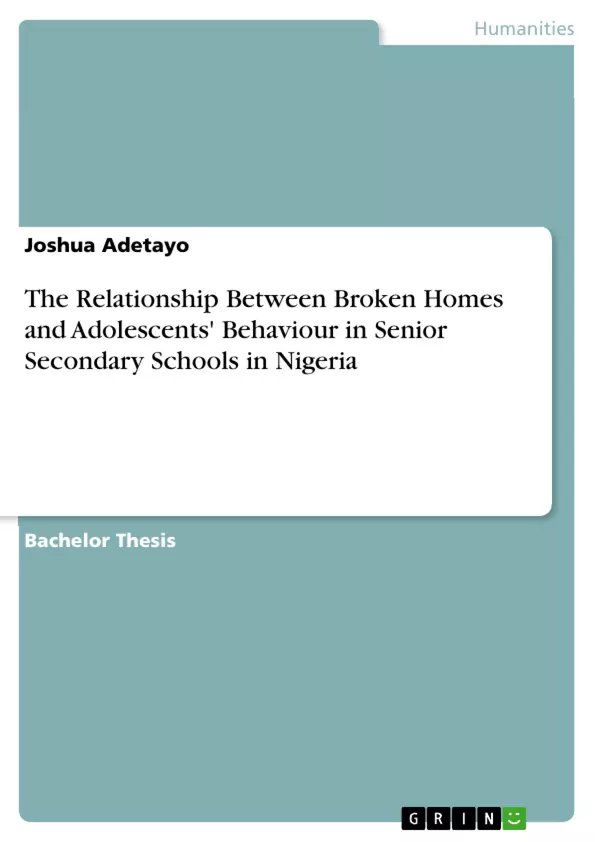The aim of this study is to investigate the relationship between broken homes and adolescents behaviour in Senior Secondary Schools. Four research questions were raised: What are the causes of broken homes in the society? What is the relationship between broken home and the academic performance of adolescents in senior secondary schools? What is the relationship between broken homes and social relationship of the adolescents? What is the relationship between the emotional stability manifested and the gender sociorelationship of adolescents who come from broken home and those from intact home?
There is a global awareness of the importance of the home environment on adolescents’ behaviour and relationship in the society. In Nigeria, most home are not intact as a result of issues of incompatibility of the couples, misconception and misunderstanding. The home lays the bedrock of development of a child in all stages of life and it has a greater impact on how they behave in the society. Adolescents from broken home engage in risky behaviors due to lack of guidance and affection from home which makes them to be less effective among peers, schools and the society at large. The teachers commonly describe adolescents from broken homes as more hostile, aggressive, anxious, fearful, hyperactive and distractive than adolescents from intact family.
Table of Contents
- CHAPTER ONE: INTRODUCTION
- 1.1 Background of the Study
- 1.2 Statement of the Problem
- 1.3 Objective of the Study
- 1.4 Research Questions
- 1.5 Research Hypotheses
- 1.6 Significance of the Study
- 1.7 Scope and Delimitation of the Study
- CHAPTER TWO: REVIEW OF RELATED LITERATURE
- 2.0 Introduction
- 2.1 Theoretical Framework
- 2.1.1 Theory of Dysfunctional Behaviour
- 2.2 Concept of Home
- 2.2.1 Importance of the Home to a Child
- 2.3 Broken Homes
- 2.3.1 Types of Broken Homes
- 2.3.2 Causes of Broken Homes
- 2.4 Concept of Adolescent
- 2.4.1 Stages of Adolescent Development
- 2.5 Effect of Broken Homes on the Adolescents Behaviour
- 2.5.1 Maladjustment
- 2.5.2 Health Compromising Behaviour
- 2.5.3 Parental Infidelity and Adult Children's Infidelity
- 2.5.4 Attachment Implication
- 2.6 Academic Performance/Achievement of Adolescents from Broken Homes
- 2.7 Empirical Framework of the Study
- 2.8 Review of Related Empirical Studies
- 2.9 Summary of Literature Review
- CHAPTER THREE: RESEARCH METHODOLOGY
- 3.0 Introduction
- 3.1 Research Design
- 3.2 Population of the Study
- 3.3 Sample and Sampling Technique
- 3.4 Instrumentation
- 3.5 Validity of the Instrument
- 3.6 Reliability of the Instrument
- 3.7 Method of Data Collection
- 3.8 Method of Data Analysis
- CHAPTER FOUR: RESULT PRESENTATION, DATA ANALYSIS AND DISCUSSION
- 4.1 Introduction
- 4.2 Hypothesis Testing
- 4.3 Data Analysis
- 4.4 Discussion of Findings
- CHAPTER FIVE: SUMMARY, CONCLUSION AND RECOMMENDATIONS
- 5.1 Summary
- 5.2 Findings
- 5.3 Conclusion
- 5.4 Recommendations
- REFERENCES
- APPENDIX I
- APPENDIX II
Objectives and Key Themes
This study aims to explore the connection between broken homes and the behavior of adolescents attending senior secondary schools in Ondo State, Nigeria. The research investigates the impact of family structure on adolescents' social relationships, emotional stability, and other aspects of their well-being. The study employs a descriptive correlational research design, utilizing a self-developed questionnaire to collect data from teachers in Ondo West.
- Impact of broken homes on adolescent behavior
- Influence of family structure on social relationships
- Relationship between broken homes and emotional stability
- Academic performance of adolescents from broken homes
- The importance of parental involvement and support for adolescent development
Chapter Summaries
The first chapter provides a background on the study, defining key concepts such as "home," "family," and "broken homes." It also outlines the research problem, objectives, questions, hypotheses, and the significance of the study. Chapter two delves into the theoretical and empirical frameworks surrounding the topic. It explores the theory of dysfunctional behavior, examines the concept of home and its importance to children, and discusses the various types and causes of broken homes. This chapter also analyzes the impact of broken homes on adolescents, exploring their potential maladjustment, health-compromising behaviors, and academic performance. Chapter three details the research methodology, outlining the research design, population, sample, sampling techniques, instrumentation, validity and reliability of the instruments used, data collection methods, and data analysis approaches employed. Chapter four presents and discusses the results of the study, including data analysis and hypothesis testing.
Keywords
This study focuses on key concepts such as broken homes, adolescent behavior, social relationships, emotional stability, academic performance, family structure, and parental involvement. The research utilizes a descriptive correlational research design to analyze the relationship between these factors and the well-being of adolescents in senior secondary schools in Ondo State, Nigeria.
- Citation du texte
- Joshua Adetayo (Auteur), 2021, The Relationship Between Broken Homes and Adolescents' Behaviour in Senior Secondary Schools in Nigeria, Munich, GRIN Verlag, https://www.grin.com/document/1159545



